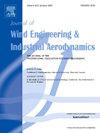Investigation on vortex-induced vibrations of dual parallel suspenders with different diameters: An enhanced response phenomenon
IF 4.9
2区 工程技术
Q1 ENGINEERING, CIVIL
Journal of Wind Engineering and Industrial Aerodynamics
Pub Date : 2025-10-10
DOI:10.1016/j.jweia.2025.106250
引用次数: 0
Abstract
A suspender design with differing diameters was investigated during the conceptual phase. To evaluate the feasibility of this configuration, wind tunnel tests were conducted on a section model of the suspenders. An enhanced vortex-induced vibration (VIV) response was observed in the downstream suspender, which had a larger diameter than the upstream suspender. The vibration response, motion trajectories, and frequency spectrum of the suspenders were first investigated. Furthermore, aerodynamic damping ratios, surface wind pressures, and vortex evolution were analyzed to explore the mechanisms behind the response enhancement phenomenon. Results show that aerodynamic interference from the upstream suspender amplified the downstream response, reaching a maximum magnitude 2.2 times that of a single suspender. The aerodynamic negative damping effect is evident during the VIVs of the suspenders. Enhanced VIV response in the downstream suspender is associated with the dominance of cross-wind pressure modes, which account for 69 % of the total energy. Simultaneously, the newly formed downstream vortices with negative pressure merge with the vortices reaching from upstream, synergistically increasing the resultant cross-wind force. Findings suggest that the VIV response of the suspender can be enhanced at a specific spacing, indicating that using suspenders of different diameters should be approached with caution or avoided.
不同直径双平行悬架涡激振动研究:一种增强响应现象
在概念阶段,研究了不同直径的悬架设计。为了评估这种结构的可行性,对吊杆的截面模型进行了风洞试验。在直径大于上游悬架的下游悬架中观察到增强的涡激振动(VIV)响应。首先对悬架的振动响应、运动轨迹和频谱进行了研究。此外,还分析了气动阻尼比、地面风压和涡的演变,以探讨响应增强现象背后的机制。结果表明,来自上游悬架的气动干扰放大了下游响应,最大振幅是单个悬架的2.2倍。悬架在涡激振动过程中存在明显的气动负阻尼效应。下游悬架的涡激振动响应增强与占总能量69%的横向风压模式的主导地位有关。同时,新形成的下游负压涡旋与上游到达的涡旋合并,协同增加了合成的侧风力。研究结果表明,在一定的间距下,悬架的涡激振动响应可以增强,这表明应谨慎对待或避免使用不同直径的悬架。
本文章由计算机程序翻译,如有差异,请以英文原文为准。
求助全文
约1分钟内获得全文
求助全文
来源期刊
CiteScore
8.90
自引率
22.90%
发文量
306
审稿时长
4.4 months
期刊介绍:
The objective of the journal is to provide a means for the publication and interchange of information, on an international basis, on all those aspects of wind engineering that are included in the activities of the International Association for Wind Engineering http://www.iawe.org/. These are: social and economic impact of wind effects; wind characteristics and structure, local wind environments, wind loads and structural response, diffusion, pollutant dispersion and matter transport, wind effects on building heat loss and ventilation, wind effects on transport systems, aerodynamic aspects of wind energy generation, and codification of wind effects.
Papers on these subjects describing full-scale measurements, wind-tunnel simulation studies, computational or theoretical methods are published, as well as papers dealing with the development of techniques and apparatus for wind engineering experiments.

 求助内容:
求助内容: 应助结果提醒方式:
应助结果提醒方式:


